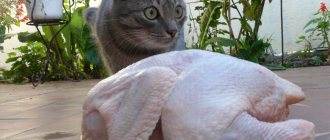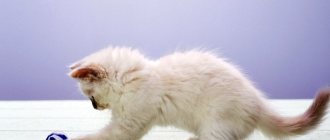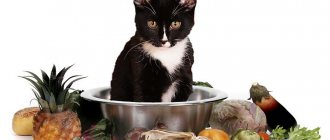Although veterinarians strongly recommend not feeding their pets from the table, many pet owners continue to regularly leave their pet scraps or are manipulated into sharing a tasty morsel. Human food is not always suitable for cats and often provokes serious diseases. Sweet and salty foods can be especially harmful.
Why lard is bad for your cat's health
Many experienced cat owners know that their pet should not be fed pork or lard. This knowledge is “transmitted” to everyone who asks for advice, but not everyone can explain why lard is harmful to a cat’s health.
Not only lard, but pork in general, has received the most undeservedly bad reputation among animal feed products. In fact, pig meat and pork fat are often included in high-quality industrial feeds, so its complete exclusion from the diet is not always necessary or reasonable.
Pork is not the optimal choice for feeding - that's a fact. The simplest and most basic explanation is that feral cats do not prey on feral pigs. Natural prey for cats are small rodents and birds, and for large wild cats - artiodactyl herbivores. That is, for domestic cats, the optimal meat ingredient in the diet is rabbit, poultry or beef.
Note! It is not recommended to include raw lard and meat in your cat’s diet, as well as smoked pork.
Despite the “far-fetched” talk about the dangers of pork and lard, there are still some serious risks when including it in a cat’s diet :
- Trichinosis is a parasitic disease that originates from raw pork. Unlike most common worms, these parasites “settle” in the liver and can quietly harm a cat for many years. Trichinosis is very dangerous for your pet's health! The longer the worms live and multiply in the liver, the more serious the damage. The liver is one of the organs that recovers quickly, but trichinosis can lead to irreversible damage.
- Increased fat content - pork is considered too fatty meat to be included in the diet of pets. Lard can only be used as a supplement that is recommended by a veterinarian. However, lean pork, which contains a minimal amount of fat, can be included in the pet's diet in heat-treated form.
- Allergies - there are no official statistics, but the practical experience of veterinarians shows that about 30% of cats suffer from an allergy to pork. Symptoms of an allergic reaction include skin itching, hyperactive mucous membranes, the appearance of an unpleasant odor from fur and skin, and indigestion. If one or more allergy symptoms appear, pork, including offal, must be excluded from the cat's diet.
Note! A cat's natural diet can include pork by-products, such as liver, kidneys, lungs, and heart. Naturally, by-products must be heat-treated.
Herring
By feeding your cat herring, you supply his body with an enzyme, trimethylamine oxide, which destroys vitamin B1, which is necessary for the normal functioning of all metabolic processes in it. This enzyme is concentrated mainly in the heads of the herring, as well as in the insides - these are the parts that the pet often gets when cutting the fish.
By the way, due to the hormone contained in herring, cats often experience anemia - their body begins to poorly absorb iron.
Paul McCartney's eldest grandson looks like his copy in his youth: photo
Sponge-apple cake with cream can be prepared both on holidays and on weekdays: recipe
There were just trucks, there were hot rods: a dozen modified cars
Don’t forget that canned herring, which people often feed to their cats, has a laxative effect on the pet’s digestive system.
How to help a cat if she feels sick from lard
Many owners exclude pork and lard from their pet's diet to be on the safe side. However, few people know what to do and how to help a cat if it becomes ill from lard. Quite often, owners are faced with a situation where a cat sneaks onto the kitchen table and eats a large amount of lard, tempted by its aroma.
The first conclusion to be drawn is that your pet is sorely lacking in protein. If you feed your cat commercial food, do not hesitate to switch it to higher quality products. If your pet is on natural food, it is necessary to increase the quantity or quality of protein products.
A cat only needs to eat a little bit of lard to get sick. Despite the fact that a cat's digestive system is adapted to digest large volumes of fairly fatty foods, pure fat can cause the intestines to stop working.
In the “best” case, the pet will experience severe abdominal pain and diarrhea. Nausea, vomiting, and temporary refusal to eat may occur. These symptoms indicate that the body is coping with digestion on its own.
Natural cat food
Owners often panic because their cat stole a piece of salted fish, and on cat forums real verbal skirmishes sometimes flare up, caused by the fact that someone treated the cat with a spoonful of salted caviar or a piece of salted cheese... Is it true that this is so harmful for cats? salt and what to do if your cat has eaten something salty?
Can cats eat salt?
Let me start with the fact that if your cat has eaten salty food, you don’t need to grab your head, tear out your hair, give your cat an enema, shove tons of adsorbents into it and run to read what the Internet thinks about how long your cat has left to live. Cats can safely be given table salt as part of other foods. Table salt is not dangerous to their health, provided that the cat has unlimited access to clean drinking water. Even food for cats with kidney problems adds salt to increase fluid intake, since most cats are reluctant to drink on their own, and high fluid intake is especially important for cats with health problems. Therefore, cats can all the more be treated to salted cheese, salted fish, salted caviar, etc., if the cat shows interest in these products. They will not cause any harm if they are given as a treat and do not become a replacement for a full diet. Moreover, the addition of NaCl helps cats lower the concentration of urine, which helps dissolve, flush out, and prevent stones, both struvite and oxalate. Those. Contrary to the fears of owners, sodium chloride, on the contrary, helps fight stones, and does not increase the likelihood of their occurrence (1).
Some homemade diet recipes also intentionally add salt, sometimes iodized, since cats have a physiological need for the elements that make up table salt - both sodium and chlorine in certain quantities (according to the NRC this is 42 mg and 60 mg, respectively, per day per day). one average cat). Sodium performs a transport function between cell membranes and plays an important role in maintaining acid-base balance, osmotic pressure and a constant blood pH level. Chlorine, among other things, is important for normal digestion, as it participates in the formation of hydrochloric acid, which is the main component of the cat's gastric juice.
In nature, a cat always has enough salt, which it receives from its prey, since salt is part of the prey’s blood. Since the meat is bled before sale, there is less salt in it, but even this is enough to satisfy the cat's needs for Na and Cl. For comparison, the sodium content in 100 g of raw veal is 86 mg, beef kidney is 182 mg, and raw chicken is 77 mg. That is, even 100 g per day of any raw meat product will more than cover the minimum sodium requirements of any cat, so we still do not see the need and do not recommend adding salt to cat food on purpose. It is better to find frozen pork or beef blood on sale and add it.
Another amazing fact that is hard to believe is that cats can stay hydrated by consuming sea water... did you know? We heard, but refused to believe it, until it became too difficult to argue with a three-volume book on animal physiology. The harm of salt to cats (up to fairly high concentrations) is a myth. I will not go into details and consequences of this fact, except that do not be afraid to take your pet for long walks to the sea on a hot, fine day. He will be able to quench his thirst right on the shore without negative consequences for his health (2).
Many mammals can drink saline solutions up to certain concentrations. For example, a cat and a camel can maintain their hydration by consuming seawater; the same applies to the kangaroo rat. In humans, limiting the consumption of sea water is apparently not associated with the kidneys, but with its effect on the gastrointestinal tract and blood vessels. Mammalian kidneys are very well adapted to produce urine that is hyperosmotic to blood. The concentration of urine... of some mammals can be 20 times higher than the concentration of their plasma.
Some owners report that their outdoor cats find and enjoy licking natural licks—deposits of minerals and salts on the soil surface. However, salt licks are not usually offered to predators. Although cats may naturally lick soil rich in mineral salts, you should be careful with large pieces of salt. Especially with salt lamps. Uncontrolled access to lump salt can lead to poisoning, despite the fact that cats have a fairly high toxicity threshold. However, salt is not as toxic to cats as it is to other animals.
If you still have questions, you can contact us for a paid on-line consultation. To do this, write to us by email: [email protected]
Authors of the article: Veronika Kozyreva, Yulia Brovko Photo: Veronika Kozyreva
1. Increasing dietary sodium chloride promotes urine dilution and decreases struvite and calcium oxalate relative supersaturation in healthy dogs and cats — Yann Queau, Esther S. Bijsmans, Alexandre Feugier, Vincent C. Biourge, March 2020
2. Comparative physiology of animals in 3 volumes. Volume 1, 143-144 pp. Ed. prof. L. Prosser Year of publication: 1978 Publisher: Mir
Other foods prohibited for cats
To maintain your pet’s health, it is extremely important to exclude other foods prohibited for cats from the diet:
- Products containing sugar or its substitutes, xylitol (chewing gum, some sweets), flour or yeast, caffeine, cocoa, any stimulants (sweets, tea, coffee, chocolate), marinades, salt, spices.
- Bones, pure fat, skin, especially poultry.
- Palm oil.
- Grapes, raisins, juicy and sweet fruits.
- Soy, mushrooms.
- Corn and semolina.
- Raw, freshwater, dry, salted fish.
- Smoked products, including sausages, balyki, fish.
- Expired products.
- Leftovers from the table.
- Dog food.
Many veterinarians and experienced owners recommend eliminating grains from a cat's diet. The fact is that the cat’s body synthesizes enough carbohydrates to nourish the nervous system. The rest of the body's systems receive energy from proteins. Cereals are included in a pet’s diet only if there is a lack of energy. For example, young, active and rapidly growing cats include rice and buckwheat in their diet. If the cat is gaining weight or has become less active, grains should be excluded from the diet.
Why can't cats have sweets?
Giving cats and cats sweets is not recommended for many reasons, the main of which is the body’s lack of need for carbohydrates.
In addition, eating sweet foods leads to various diseases.
For example, theobromine contained in chocolate is harmful to cats, causing poisoning.
Cakes, sweets and condensed milk are rich in carbohydrates, which, if not digested, contribute to the cat's weight gain and cause obesity, which, in turn, increases the load on the joints.
If a cat has eaten a lot of sweets, the consequences can be sad and quite varied, ranging from diarrhea to hair loss.
Attention! Do not forget that a large amount of sugar in the body causes diabetes.
When a cat eats sweets, the immune system will also deteriorate, weakening its protective properties.
Also, due to poor digestibility, the entire digestive system of the animal is at risk.
Why cats can’t fish – the harm of fish products and feeding
When preparing a healthy diet for a domestic cat, many owners are faced with the conviction of many veterinarians who do not recommend adding different types of fish to the animal’s daily menu. In our article we will look in detail at the question of why cats should not fish and what the consequences of regular feeding with this product can be.
Let's start by destroying the stereotypes that have developed over the years: wild domestic cats have always eaten fish, independently caught tasty prey from lakes and rivers, and in general, this product is the basis of their diet.
This is an absolutely erroneous misconception, since by their nature cats are very afraid of water, so they have never been keen on fishing. People came up with a fish menu for domestic cats because of the availability of the product and its comparative cheapness.
Should I add salt to my cat's food?
Salt, as a rule, is not added to natural foods. But there is one “but”. The fact is that most of the salt is contained in the blood, and butchers drain the blood - and very little of it remains in the meat. That is, the meat loses its natural saltiness. Not to zero, but not reaching the norm either. How to solve this problem?
You can give your cat organs that represent a blood depot: the liver and spleen. Blood clots are also found in hearts. Heart can be given in unlimited quantities, and liver and spleen can make up up to 5% of the diet, because in large quantities cause side effects, in particular diarrhea.
If the cat does not consume these organs, blood can be purchased separately. Some butchers sell it. If you buy liquid blood, it must be frozen for at least three days before use, just like meat. For convenience, the blood can be poured into ice cube trays. And then add one cube at a time to the plate along with food.
And after defrosting, do not pour out the blood that is contained in the pieces of meat that you feed the cat, but carefully pour it into the cat’s bowl.
Thus, if a cat regularly consumes meat with a small blood content or bloody organs, the food does not need additional salting. But, if there are no such products in the diet, many nutritionists believe that it is still necessary to periodically add salt to the meat: at the rate of 0.5-0.9 grams of salt per 1 kg of meat. In this way we recreate the natural saltiness of the flesh and blood.
Instead of salt, you can add a small piece of sea fish to your food or have one fish meal per week: there is more salt in sea fish than in meat. This does not mean canned or dried fish, but raw or boiled (baked).
Another option is to put two bowls of water: one with an isotonic solution of water (0.9% salt, which corresponds to the natural salinity of the blood), the second with fresh water. The cat will choose what to drink. If your cat drinks salt water, it means that she really does not have enough sodium chloride.
Many people ask what to do if a cat licks salt? Most likely, this means that there is not enough of it in the diet. Then follow the advice in this article on how to properly give salt to your cat. But you shouldn’t let him drink too much at one time: this can lead to poisoning.
The role of salt in cat metabolism
Like sugar, salt plays a vital role in the metabolism of living organisms. Therefore, of course, it is impossible to completely eliminate salt from an animal’s diet. And here the question of the norm arises. What is the optimal amount of salt for furry pets? Modern experts are of the opinion that salt (as well as sugar) is present in the natural diet of animals, and this amount is more than enough, that is, there is no need to additionally offer the animal sodium chloride.
Yes, meat contains very little carbohydrates and salt, but since ancient times the cat’s body has been adapted to precisely this amount of salt. More salt in the body will cause the cat to drink more, and this will cause the leaching of minerals. In addition, excessive salt consumption leads to metabolic disorders and, as a result, serious health problems.
But a complete absence of salt is not good. Sodium chloride has many beneficial functions in the body. Firstly, it is an element of metabolism that ensures proper nutrition for cats. Cell walls allow salt and nutrients to pass through, which displace potassium and waste products. If there is no salt in the body, there will be nothing to squeeze potassium out of the cells - this will lead to intoxication and death of living tissues.
In addition, salt promotes the digestion of food, as it is part of the gastric juice. A deficiency of sodium chloride leads to incomplete absorption of food, metabolic disorders, and the development of diseases.
What kind of salt should I give my cat?
If you decide to periodically add salt to your cat’s food, you need to understand that not just any salt is suitable. Yes, the formula is sodium chloride (NaCl). However, the product is different from the product. For example, you should not use extra salt, which is subject to harmful processing. It is better to give rock or sea salt, as well as pink Himalayan salt, which is also supplied with other useful trace elements.
Can cats eat salted saddle as a source of sodium chloride? If there is nothing in it except salt, then again, as a small and rare addition to the main menu, herring is acceptable and even healthy. Likewise salmon and mackerel. But still, it is better for people to avoid salty foods and prefer fish that has not been artificially added.
Among other sources of salt, seaweed is suitable as a food additive. Just before serving in a bowl, for example, with meat or cottage cheese, it needs to be soaked in boiling water and chopped.
But if your cat eats pickles, olives, dried and dried fish, this is already bad. We need to figure out whether he really needs salt there? Perhaps he likes some other taste. For example, cats, like people, are susceptible to monosodium glutamate. But, one way or another, there is nothing useful in any canned food for a cat.
How much fish can you give your cat?
After reading numerous arguments about the dangers of fish for domestic cats, many owners have a very obvious opinion - this product will have to be completely excluded from the animal’s diet. But this is not entirely true; you can give your cat fish, but sometimes, in a certain quantity and not of all types.
This product, despite numerous harmful components, is still necessary for the animal to maintain normal functioning of the cardiovascular and nervous systems. In order not to cause harm and create an extremely healthy menu for your furry friend, we recommend following the following advice from veterinarians:
- It is better to feed your cat boiled fish. During the heat treatment, dangerous components are destroyed, and helminthic eggs are also destroyed.
- You can serve a fish dish no more than once a week.
- Castrated and sterilized cats are fed fish no more than 2 times a month.
- The animal's diet should contain only sea fish without bones! River species are absolutely unsuitable for domestic cats, as they contain too many small bones that can injure the throat and mucous membranes of the gastrointestinal tract.
- Young cats can be periodically pampered with fatty fish, but mature cats are better fed exclusively with dietary varieties.
- You should not feed your cat fish during pregnancy. The substances included in its composition may adversely affect the development of the fetus.
- The fish must be deboned or choose ready-made fillets that do not require additional processing before feeding.
- Portions should be moderate, appropriate for the weight and age of the pet. Do not serve the dish in large quantities, the cat may not be able to resist such a tasty temptation and will eat to its heart’s content, and this is already fraught with very unfavorable consequences!
- Fish can be served in combination with a side dish, for example, freshly prepared cereal porridge or vegetable puree.
- Do not mix fish with dry and wet food. This type of lunch will not be good for your furry friend.











